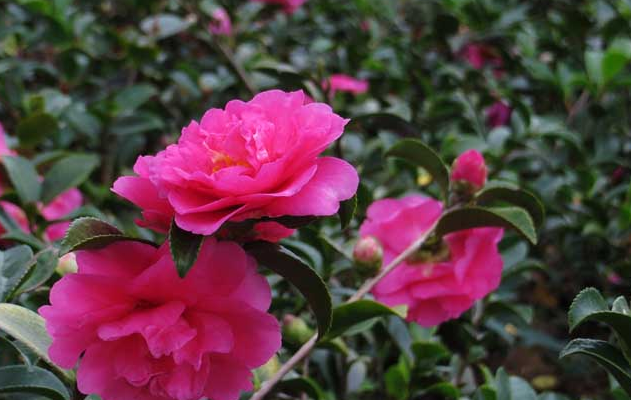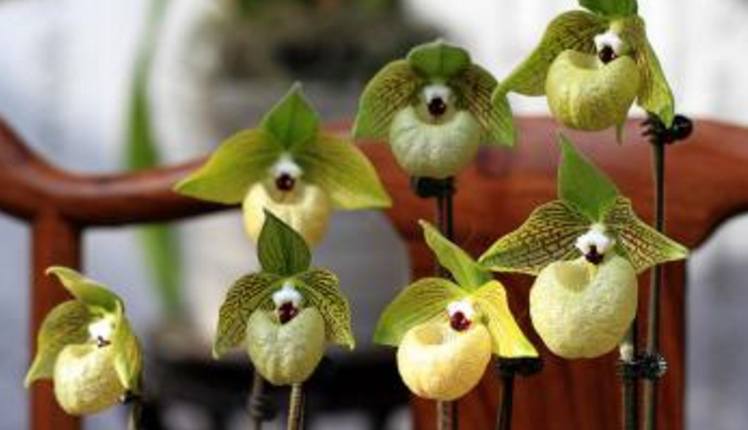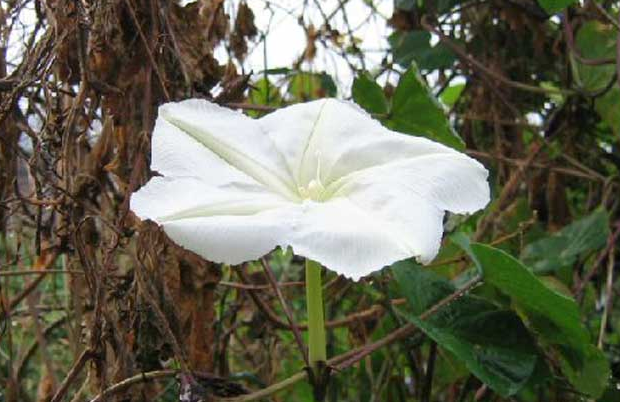What is the method of cultivation and precautions for tea plum?
Tea plum, this is a kind of plant, many people may have heard that the flower is really delicate and beautiful, it is really super good-looking, what are the breeding methods and matters needing attention of tea plum? What is the breeding method of tea plum:

Culture methods and matters needing attention of tea plum:
1. Soil: Camellia oleifera is suitable for growing in acid sandy soil with loose fertility and good drainage, alkaline soil and clay are not suitable for planting, and lime soil is more taboo to be used. when potted in the north, it is appropriate to choose rotten leaf soil or peat soil, plus a small amount of river sand culture soil.
2. Watering: tea plum should be watered to keep the basin soil moist without stagnant water. It should be watered once every morning and evening in summer and once in several days in winter. In addition to winter, should also spray water to the leaf surface every few days, in order to keep the leaf surface clean, watering must be thoroughly watered.
3. Sunshine: Camellia oleifera is a semi-shady plant, avoid strong light. Generally, it should be cultured in the shade from May to September every year. If it is directly exposed to the hot sun, it is very easy to burn leaves and buds, causing leaves to curl and scorch and fall off in serious cases. We need more sunshine in late autumn and winter.
4. Temperature: tea plum likes warm environment, and the suitable temperature for growth is 18-25 ℃. The temperature should not be too high. When the temperature exceeds 35 ℃, the tender leaves are prone to birthday burn. At the same time, Camellia oleifera has strong cold tolerance and can be kept in a cold room of more than 2 ℃ in winter.
5, fertilization: tea plum fertilization strives to be light and fully mature, and the application of raw fertilizer or thick fertilizer will burn the roots, especially the seedlings in 2012. In general, a dilute nitrogen fertilizer was applied from February to March to promote the growth of branches and leaves. A thin cake fertilizer and water was applied from April to May to facilitate flower bud differentiation. 0.2% potassium dihydrogen phosphate was applied from September to October to make the flowers bright.
6. Insect pests: tea plum has fewer diseases and insect pests, and the main diseases are gray spot, soot, anthrax, etc., which should be prevented and treated early. Once the disease occurs, it can be sprayed with the same amount of Bordeaux solution 300 times. If there are shell insects, red spiders and other damage, can be brushed off manually, there are red spiders, can be used to bubble tobacco water mixed with pepper water spray, the effect is also very significant.
7. Pruning: tea plum and camellia also need to timely thinning buds and cutting off residual flowers in order to reduce nutrient consumption. In general, each branch leaves 1 bud, the rest are sparse, so that nutrients are concentrated, then the flower is large and colorful. Cutting off the residual flowers in time can not only keep the plant shape beautiful, but also conducive to the germination of new branches, but also promote the healthy growth of the plant.
The propagation method of tea plum:
Camellia oleifera can be propagated by cutting, grafting, pressing and sowing, and it is generally multipurpose. The cuttings were carried out in May, and the cuttings were selected from the strong branches on the mother plant for more than 5 years, with ears at the base, cut off the redundant leaves in the lower part, and retained 2-3 leaves. Short ears with single buds can also be cut as cuttings and cut as they are cut. The bed should be shaded, it can take root in about 20 to 30 days, and gradually pass through the light in the morning and evening.
This is the end of the introduction to the breeding and breeding methods of tea plum. Why don't you raise such a beautiful flower quickly?
Culture methods and matters needing attention of tea plum
Camellia oleifera is a common ornamental plant distributed in southern China. It has elegant leaves, bright flowers and a long flowering period. It is a characteristic plant that integrates ornamental flowers and foliage. It is usually suitable to be potted and cultivated at home. But do you know how to cultivate tea plums? Do you know what you should pay attention to in culturing tea plum? If you don't know, hurry up and get to know with the editor.
Culture methods of tea plum
1. Soil
At ordinary times, when cultivating tea plum, we must choose a suitable soil, the soil should be loose and fertile, and the drainage is smooth, it is best to use rotten leaf soil and peat soil together to make cultivation land. And when cultivating tea plum, you should choose an one with strong water absorption, and cover the bottom of the flowerpot with coarse sand, which is conducive to air permeability and drainage.
2. Appropriate fertilization
At ordinary times, when cultivating tea plum, it must be fertilized appropriately, because it does not have high requirements for fertilizer, especially in its seedling stage, otherwise it will affect its seedling growth, and for tea plum that has just been transplanted, it should not be fertilized prematurely, otherwise it will burn roots and let the plant die.
3. Culture environment
Tea plum must be cultured in a suitable environment at ordinary times. It is a kind of shade-loving plant. It must be shaded in time in summer and high temperature. Even after entering the cold winter, tea plum can not be placed directly under strong light, otherwise its leaves will appear curly, and the number of flowers will be significantly reduced.
Matters needing attention in culture
Tea plum culture must pay attention to moderate watering, can not let the basin soil too wet, otherwise it will affect the permeability of the soil, if too much watering, but also easy to cause disease, under normal circumstances, every 4 to 5 days watering can, but in hot summer weather, need to spray water to the plant leaves every day. In addition, the cultivation of tea plum to use the new flowerpot is to soak the flowerpot in clear water for 24 hours, let the pot heat out before you can plant tea plum, otherwise it is very difficult for tea plum to survive.
How to raise tea plum, the culture methods and precautions of tea plum / avoid bright light
Tea plum and plum blossom are certainly no strangers. They are one of the top ten famous flowers in China. Do you know tea plum? It is understood that tea plum is named for its leaves like tea and flowers like plum. It is a beautiful flower. In life, many novices want to know how to raise tea plum. In this regard, the editor carefully sorted out the breeding methods and matters needing attention of tea plum. Friends who want to raise come in and have a look!
First, how to raise tea plum and create an environment
Tea plum, which combines the advantages of tea plum and plum blossom, is amazing when you think about it, so it is loved by many people. As for how to raise tea plum, we need to create the most favorable environment for tea plum according to its growth habits. In this regard, the editor will elaborate on the breeding methods and matters needing attention of tea plum from the aspects of soil, light, watering and so on.
II. Culture methods and matters needing attention of tea plum
1. Soil, slightly acidic
How to raise tea plum, the first thing is to choose the soil, even if you buy tea plum potted plants directly from the florist, you also need to change the soil. According to the growth habits of Camellia oleifera, we should choose acid sandy soil with loose, fertile and good drainage.
Note: in order to ensure good drainage, it is best to choose a mud basin with good air permeability and strong water absorption, and lay a layer of coarse sand or coarse slag at the bottom of the basin to facilitate drainage and air permeability.
2.Illumination, avoid strong light
In the cultivation methods and matters needing attention of tea plum, light should be paid more attention to. It is understood that tea plum is a semi-negative plant, it likes light and slightly tolerant of shade, avoid strong light, so it is best to grow in a half-yin and half-yang environment. Proper lighting can promote the blooming and blooming of tea plum flowers.
Note: in the summer sun, we must give tea plum shade, otherwise the strong light may burn its leaves and branches, resulting in tea plum leaves yellowing, curling, or even falling off, seriously affecting its ornamental.
3. Temperature, 18-25 ℃
Tea plum likes a warm environment, slightly hardy, the best growth temperature is 18-25 ℃, if you want tea plum to grow well, it is best to keep it in this temperature environment.
Note: although tea plum is hardy, it is best not to be less than minus 2 ℃ in potted plants, otherwise it is easy to freeze, and plant growth will be affected. So in winter, we should move the tea plum indoors to spend the winter, it is best to keep the room temperature 3-6 ℃, other seasons in the shade can be maintained.
4. if you water it, you will water it thoroughly.
How to raise tea plum, watering is a very key link. It is understood that tea plum likes a humid environment, we should water it frequently, but every time we water it thoroughly! In spring and autumn, water tea plum once a day to keep the basin soil moist; in summer, once in the morning and evening every day; and in winter, once in several days.
Note: the watering of tea plum depends on the situation, but it is too wet so as not to affect the soil permeability, and too much watering can easily cause a super disease. In addition to winter, water should be sprayed to the leaves every few days to keep the leaves clean.
5. Fertilizing, applying thin fertilizer frequently
Tea plum does not have high requirements for fertilizer and water, so we want it to grow fast, it is best to apply thin fertilizer diligently. Generally, human urine can be applied 1 or 2 times from February to March to promote the growth of branches and leaves, cake fertilizer and water once from April to May to promote flower bud differentiation, and phosphate fertilizer from September to October to promote its flowering, which is also beneficial to winter.
Note: tea plum fertilization is suitable for light, especially in the seedling stage, not early fertilization, so as not to cause burning seedlings; in addition, just transplanted tea plum, fertilization also need to pay attention to, once too much fertilization, easy to burn seedlings, resulting in dead plants.
- Prev

What are the effects and functions of the maintenance method of the turnip orchid
Paphiopedilum unique shape, rich flower color, flowering life is longer, potted as for home viewing leaves flowers, edify sentiment! The maintenance method of turnip orchid can not be as simple as you think, Xiaobian today will take you to understand the maintenance method of turnip orchid and the efficacy and function of turnip orchid. The maintenance method of Paphiopedilum
- Next

How to reproduce the culture method of moonlight
Moonlight flower, this is a kind of plant, the name of this moonlight flower is also strange, how to feel like the moonlight clan, what is the breeding method of moonlight flower? How to reproduce the moonlight flower: the culture method of the moonlight flower: 1. Soil: the moonlight flower likes the soil environment where the tide is dry.
Related
- Fuxing push coffee new agricultural production and marketing class: lack of small-scale processing plants
- Jujube rice field leisure farm deep ploughing Yilan for five years to create a space for organic food and play
- Nongyu Farm-A trial of organic papaya for brave women with advanced technology
- Four points for attention in the prevention and control of diseases and insect pests of edible fungi
- How to add nutrient solution to Edible Fungi
- Is there any good way to control edible fungus mites?
- Open Inoculation Technology of Edible Fungi
- Is there any clever way to use fertilizer for edible fungus in winter?
- What agents are used to kill the pathogens of edible fungi in the mushroom shed?
- Rapid drying of Edible Fungi

